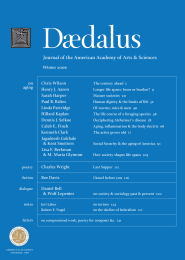Aging, inflammation & the body electric
In a famous photograph of Walt Whitman taken in the 1860s (see inside back cover), the great American bard looks wizened–his hair white, his face weathered. He looks, in short, like an old man. In fact, he was only in his forties.
During the Civil War, Whitman spent hours each day in hospital wards attending to desperately sick soldiers, which exposed him to dysenteries and horribly infected wounds. As a result, a bad infection in one hand climbed up into his shoulder, and he became beset by chronic headaches and fevers.
One hundred and fifty years after Whitman sang “the body electric,” we can find in Whitman’s fate some clues to the nature of aging. For much of his adult life, he complained of chronic headaches, fevers, and weakness. At the age of 55, he suffered a stroke that paralyzed his left side. Other strokes followed, though without noticeably impairing his memory. Whitman eventually lived to the age of 72, exceeding his generation’s life expectancy by about thirty years. Yet shortly before his death, one of his doctors noted, “His apparent age was greater than his real years.”
A postmortem by experts in gross morbid anatomy showed that Whitman had long suffered from both meningitis and tuberculosis. Tuberculous meningitis may have contributed to his strokes and would have been consistent with his other reported ailments. Both infections inflame arteries at the base of the brain, which, in turn, increases the risk of infarcts and strokes that selectively damage deep brain centers in a ‘TB zone,’ but usually spare higher cognitive functions. Although tuberculous meningitis is a rare disease, the ‘Whitman case’ points us to more general principles in aging.
Inflammation is increasingly recognized as fundamental to aging. As modern medicine has brought infectious diseases like tuberculosis and meningitis under control, successive generations have had to carry less of the inflammatory burden of such diseases–which may help account for recent improvements in human longevity. Changes of the inflammatory burden may also anticipate limits ahead. Aging, of course, is an immensely complex process governed by multiple gene-environment interactions. No single factor governs aging–biogerontology is a graveyard of single-cause hypotheses.
. . .
